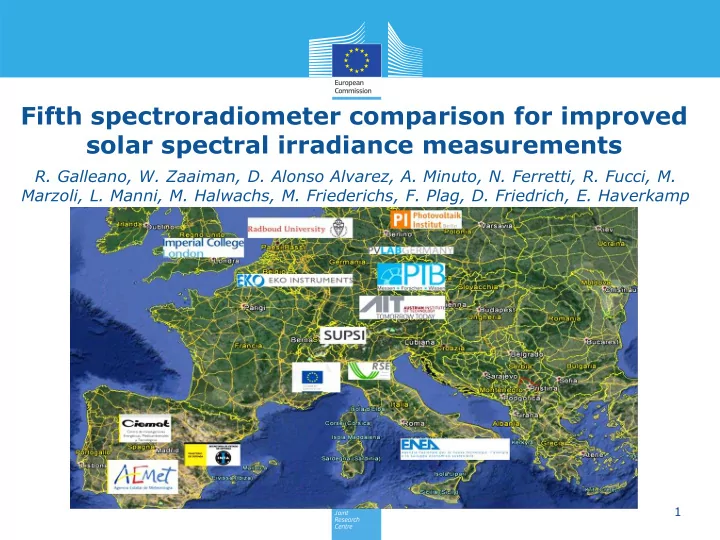

Fifth spectroradiometer comparison for improved solar spectral irradiance measurements R. Galleano, W. Zaaiman, D. Alonso Alvarez, A. Minuto, N. Ferretti, R. Fucci, M. Marzoli, L. Manni, M. Halwachs, M. Friederichs, F. Plag, D. Friedrich, E. Haverkamp 1
Rationale The wider portfolio of today’s available PV technologies with diversified spectral responsivities makes the knowledge of the light source spectrum a key parameter in calibrations Energy yield estimations/predictions in PV may improve with more accurate long term solar spectral data at specific locations Needs for an evidence-based quality-control system as required by ISO 17025 standard 2
Main scopes Comparison of calibrated spectroradiometers and secondary calibration for broadband radiometers Exchange of “good laboratory practices” on solar spectral measurements to improve accuracy Assessing equivalence level for solar spectral irradiance measurements among laboratories Reduce terrestrial and space solar cell calibration uncertainty through the dissemination of reference measurements directly traceable to the SI units 3
People and instruments involved Location: ‘ Instituto Nacional de Técnica Aeroespacial’ Madrid (E) from 18 th to 22 nd May 2015 Twentytwo people from fourteen Institutions Ten spectroradiometer systems (Wv ~300-1100 nm or ~300-1700 nm) 60+ broadband radiometers: cavity, pyrheliometer, pyranometer, PV reference and ISO-type cells 4
Some issues and challenges Use of accurate solar tracker for mounting instruments reducing angular response issues Diversified spectroradiometer technologies including mono- and poly- chromator based systems with spectral bandwidth from 0.5 to 4 nm and integration time from few milliseconds to five minutes Needs of irradiance stability ≤ 1% during the longest acquisition time assessed by cavity radiometers Cavity radiometers as link to SI units for irradiance 5
Preliminary results presented here 6
Daily wavelength-by-wavelength differences 19/05 19/05 20/05 20/05 average average average average difference std. dev. difference std. dev. 6.0% 5.0% 4.0% 3.0% 2.0% 1.0% 0.0% -1.0% -2.0% Lab B Lab C Lab D Lab E Lab F Lab G Lab H Lab I Lab L 7
Different analysis approach: Spectra shape comparison using 𝐹 𝑜 numbers (ISO/IEC 17043 on conformity assessment). Applying the ISO/IEC 60904-9, the percentage of total irradiance in six wavelength intervals is computed for the spectra under test, 𝑁𝑀𝑏𝑐 𝑗 , and compared with the reference one, 𝑁𝑠𝑓𝑔 . The observed deviations are coherent with declared uncertainty if -1< 𝐹 𝑜 <1 𝑁𝑀𝑏𝑐 𝑗 − 𝑁𝑠𝑓𝑔 𝐹 𝑜 = 𝑉𝑀𝑏𝑐 𝑗 ∗ 𝑁𝑀𝑏𝑐 𝑗 2 + 𝑉𝑠𝑓𝑔 ∗ 𝑁𝑠𝑓𝑔 2 𝑉𝑀𝑏𝑐 𝑗 = 5% and 𝑉𝑠𝑓𝑔 = 3% (k=2) 8
Wv-by-Wv Laboratory mean difference Lab B 1.9% Lab C 4.2% Lab D 1.1% Lab E -0.8% Lab F 1.0% Lab G -0.2% Lab H 4.3% Lab I 0.2% Lab L 0.3% 9
Nice, but ... What all this stuff means for PV people? Practical example: Impact of using simultaneously acquired spectra from different spectroradiometers for the calibration of a reference PV cell using a cavity radiometer as the reference device. Spectral mismatch (MM) factor calculation. 10
Data for MM calculation 0.0002 Reference cell: SR dut Reference AM1.5 spectrum: G ref 0.00015 Arbitrary unit 0.0001 Measured spectra: G meas 0.00005 𝑇𝑆 𝑠𝑓𝑔 𝜇 𝐻 𝑠𝑓𝑔 𝜇 𝑒𝜇 𝑇𝑆 𝑒𝑣𝑢 𝜇 𝐻 𝑛𝑓𝑏𝑡 𝜇 𝑒𝜇 𝑇𝑆 𝑒𝑣𝑢 𝜇 𝐻 𝑠𝑓𝑔 𝜇 𝑒𝜇 𝑁𝑁 = 𝑇𝑆 𝑠𝑓𝑔 𝜇 𝐻 𝑛𝑓𝑏𝑡 𝜇 𝑒𝜇 0 300 400 500 600 700 800 900 1000 1100 1200 Wavelength nm 11
Mismatch values computed at four different time of the day using spectra by four ‘best performing’ spectroradiometers Acquisition time 10:27 12:08 12:18 14:47 MM Lab A 1.003 1.019 1.018 1.018 MM Lab E 1.007 1.021 1.022 1.019 MM Lab F 1.003 1.020 1.020 1.019 MM Lab H 1.004 1.012 1.012 1.011 MM pk-pk difference 0.004 0.009 0.010 0.008 1% difference in mismatch values translates in 1% difference in cell short circuit current calibration value 12
Conclusions: 1-day wavelength-by-wavelegth difference relative to peak irradiance within ±3.1% Performance statistics analysis shows results of seven participants consistent with their uncertainty values Spectral mismatch pk-pk differences ≤ 1% using spectra simultaneously acquired by four spectroradiometers. This figure directly impact the calibration of primary PV detectors From first comparison edition MM difference reduced from almost 3% to 1% or better 13
14
Recommend
More recommend